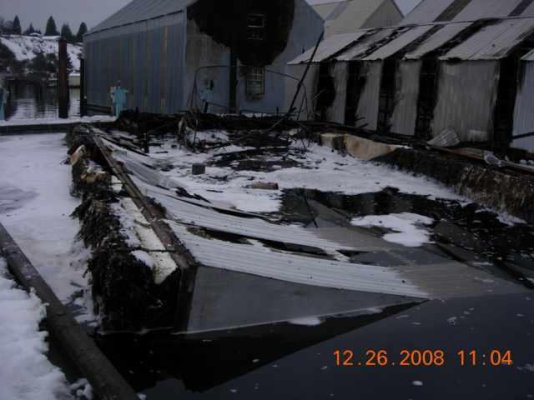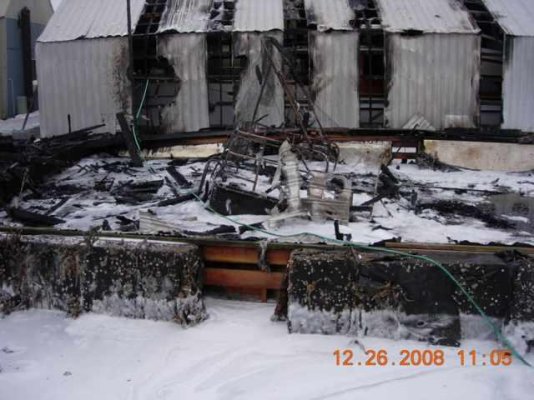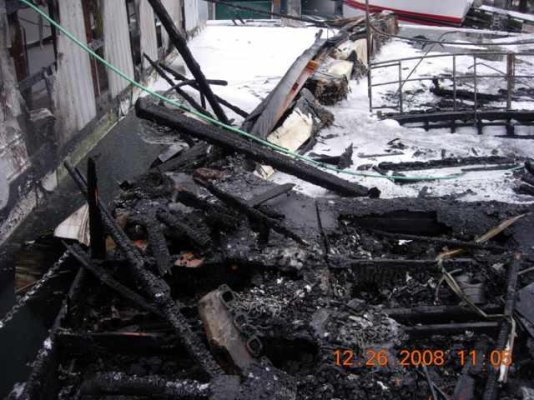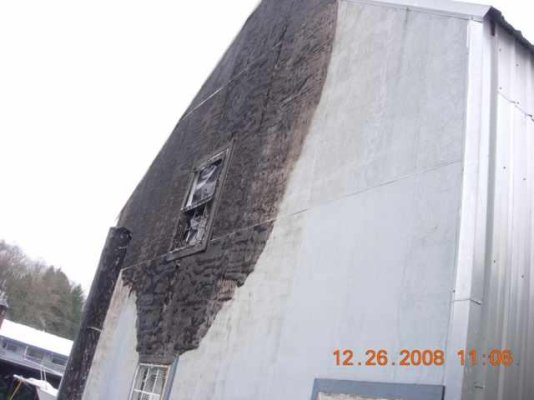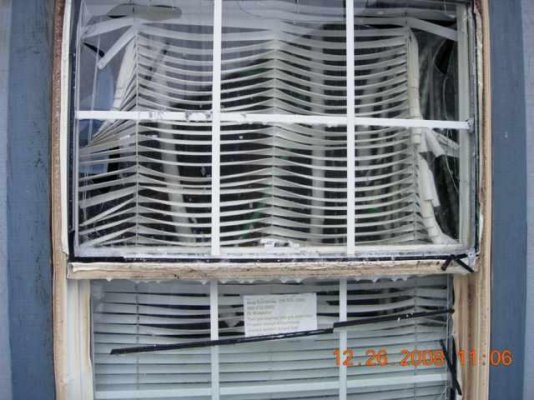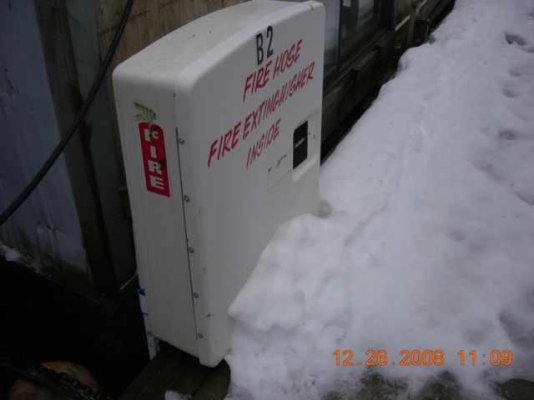2bucks
Guru
- Joined
- Oct 6, 2007
- Messages
- 698
Many of us are gripped in the icy clutches of winter.*Some of us are struggling to keep our boats from freezing when the temps drop below freezing and stay that way for days or weeks.
Below are pictures from my Yacht Club this morning. During the night, somehow,*a boat caught fire inside a boathouse. The pictures are of the boathouse next door, across the dock, and the boathouse of origin (apparently).
I make no accusations or claims of what caused the fire, how it was reported or how the fire was fought. I show you the pictures and make observations of how you and I can avoid or minimize damage to our property should this happen next to you.
1. Steel side panels. Look at the boathouse next to the one which burned. Steel keeps heat out much better than aluminum and prevents the spread of fire from house to house.*The edges of some aluminum panels have melted.
2. Fiberglass panels will melt*quickly. Depending on where the panels are, this is good and bad. If the panels*are on the sides of the house, fire is coming into your house quickly. If the panels are on the roof, it will allow heat and hot gases to escape more quickly, keeping them from banking down and moving laterally. If you are trying to fight the fire using on float hose lines, the smoke going up and out*allows you more visibility to put the wet stuff on the red stuff where it does the most good.*Water on smoke does very little*good. In no case should you*EVER be in the smoke. Only if you are saving a life should you ever even think about entering smoke. Even then it is extremely risky and should be a last resort to save a life.**
3. Know where fire hoses, extinquishers and alarms are located. Ours is kept dry during freezing weather. The*PI valve is in the parking lot. Do you know where yours is? Are your hose cabinets cleared out in front so they can be opened? Or will you be looking for a shovel to clear frozen snow and ice from infront of them while the fire burns?
4. Radiant heat can be impressive. the boathouse across the walkway has a v shaped burn mark from the window upwards. Notice the melted blinds inside the glass window. The plywood caught fire but did not burn thru. The glass window held the fire out at the base level but the window on top eventually failed. Compare the glass window with the missing fiberglass panels. Which would you rather have on the front of your boathouse?
5. Notice that the boathouse sidewalls failed inward. The long leg trusses are exposed inside most of our boathouses. The heat and flame tend to cause them to burn, lose their strength and collapse into/onto the boat inside. (the walls are built with a 6 to 12 inch tip in during construction) This again helps channel flame and heat up instead of laterally. The additional weight also tends to help sink the burning vessel. Sinking the burning vessel is both good and bad, let me explain. If the fire is burning uncontrolled which can often be the case when large amounts of water are not available, the environmental damage of sinking is not as bad as catching*additional boats on fire. The down side is that clean up and removing the hulk is complicated if it's under water. Remember we are talking about a boat that is fully involved and there is nothing in it worth saving anyway. If you've been inside houses or boats which are partially burned you already understand that it's not only the flame damage, but the heat and smoke damage which causes things to be totalled.
Many older "common cover" type boat covers have no fiberglass panels built into them. Gig Harbor experienced one of these fires a couple years ago and lost the entire string of boats. (20-30 boats if I recall correctly) the heat was trapped and radiated back down onto the boats and they had an inferno.
One picture shows a hose cabinet with snow build up in front. Our club rules REQUIRE members to clear the snow off the docks in front of their moorage area. I have another picture down one dock where there are 4 bare spots in front of boathouses. There are approximately 30 houses on each side of the dock. This is a slip and fall hazard as well as potentially a fire protection delay. What are your docks like?
Just something to think about.
Ken
Below are pictures from my Yacht Club this morning. During the night, somehow,*a boat caught fire inside a boathouse. The pictures are of the boathouse next door, across the dock, and the boathouse of origin (apparently).
I make no accusations or claims of what caused the fire, how it was reported or how the fire was fought. I show you the pictures and make observations of how you and I can avoid or minimize damage to our property should this happen next to you.
1. Steel side panels. Look at the boathouse next to the one which burned. Steel keeps heat out much better than aluminum and prevents the spread of fire from house to house.*The edges of some aluminum panels have melted.
2. Fiberglass panels will melt*quickly. Depending on where the panels are, this is good and bad. If the panels*are on the sides of the house, fire is coming into your house quickly. If the panels are on the roof, it will allow heat and hot gases to escape more quickly, keeping them from banking down and moving laterally. If you are trying to fight the fire using on float hose lines, the smoke going up and out*allows you more visibility to put the wet stuff on the red stuff where it does the most good.*Water on smoke does very little*good. In no case should you*EVER be in the smoke. Only if you are saving a life should you ever even think about entering smoke. Even then it is extremely risky and should be a last resort to save a life.**
3. Know where fire hoses, extinquishers and alarms are located. Ours is kept dry during freezing weather. The*PI valve is in the parking lot. Do you know where yours is? Are your hose cabinets cleared out in front so they can be opened? Or will you be looking for a shovel to clear frozen snow and ice from infront of them while the fire burns?
4. Radiant heat can be impressive. the boathouse across the walkway has a v shaped burn mark from the window upwards. Notice the melted blinds inside the glass window. The plywood caught fire but did not burn thru. The glass window held the fire out at the base level but the window on top eventually failed. Compare the glass window with the missing fiberglass panels. Which would you rather have on the front of your boathouse?
5. Notice that the boathouse sidewalls failed inward. The long leg trusses are exposed inside most of our boathouses. The heat and flame tend to cause them to burn, lose their strength and collapse into/onto the boat inside. (the walls are built with a 6 to 12 inch tip in during construction) This again helps channel flame and heat up instead of laterally. The additional weight also tends to help sink the burning vessel. Sinking the burning vessel is both good and bad, let me explain. If the fire is burning uncontrolled which can often be the case when large amounts of water are not available, the environmental damage of sinking is not as bad as catching*additional boats on fire. The down side is that clean up and removing the hulk is complicated if it's under water. Remember we are talking about a boat that is fully involved and there is nothing in it worth saving anyway. If you've been inside houses or boats which are partially burned you already understand that it's not only the flame damage, but the heat and smoke damage which causes things to be totalled.
Many older "common cover" type boat covers have no fiberglass panels built into them. Gig Harbor experienced one of these fires a couple years ago and lost the entire string of boats. (20-30 boats if I recall correctly) the heat was trapped and radiated back down onto the boats and they had an inferno.
One picture shows a hose cabinet with snow build up in front. Our club rules REQUIRE members to clear the snow off the docks in front of their moorage area. I have another picture down one dock where there are 4 bare spots in front of boathouses. There are approximately 30 houses on each side of the dock. This is a slip and fall hazard as well as potentially a fire protection delay. What are your docks like?
Just something to think about.
Ken

